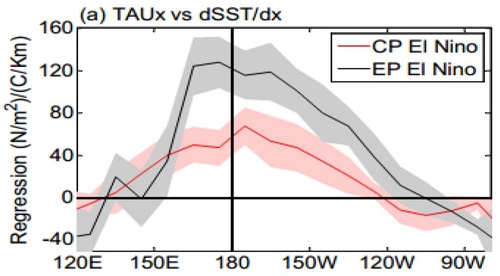Why is the CP El Nino always weaker than the EP El Nino?
Date:2014-11-02
El Ni?o–Southern Oscillation (ENSO), which is one of the most striking interannual variability in the tropical Pacific, has been extensively studied for several decades. Understanding the changes in its characteristics is still an important issue for worldwide environmental and socioeconomic interests. Recently, a new type of El Ni?o (CP El Ni?o) has been emerged, in which maximum sea surface temperature (SST) anomalies are confined mostly in the central Pacific, different from the canonical one (EP El Ni?o) that maximum SST anomalies located in the east Pacific. The more frequent occurrence of CP El Ni?o and different impacts from the EP El Ni?o on the global climate has been well documented. However, the significant asymmetry in the amplitudes between CP and EP El Ni?o has been seldom investigated.
Dr. ZHENG Fei and his team from the Institute of Atmospheric Physics found that corresponding to the pronounced amplitude asymmetry for CP and EP El Ni?o, an asymmetry in the strength of the Bjerknes positive feedback is found between these two types of El Ni?o, which is manifested as a weaker relationship between the zonal wind anomaly and the zonal gradient of SST anomaly in the CP El Ni?o. The strength asymmetry mainly comes from a weaker sensitivity of the zonal gradient of sea level pressure (SLP) anomaly to that of diabatic heating anomaly during CP El Ni?o. This weaker sensitivity is caused by (1) a large cancelation induced by the negative SST-Cloud thermodynamic feedback to the positive dynamics feedback for CP El Ni?o, (2) an off-equator shift of the maximum SLP anomalies during CP El Ni?o, and (3) a suppression of the mean low-level convergence when CP El Ni?o events occur more often.
Their findings were recently published in Geophysical Research Letters.

Fig 1. Asymmetry of the Bjerknes positive feedback between the two types of El Ni?o. The figure is the robust regression coefficients and the corresponding error bars (shaded, 95% confidence for a Student’s t test) between Taux and zonal SST gradient, illustrating the strength of the Bjerknes feedback.

Fig 2. The distributions of anomalous precipitation, total cloud amount and surface shortwave radiation for the developing phase of EP (left column) and CP (right column) El Ni?o. The negative thermodynamic feedback produced by the cloud radiative effect largely weakens the positive dynamical Bjerknes feedback for the CP El Ni?o but nor for the EP El Ni?o.
Reference: Zheng, F., X.-H. Fang, J.-Y. Yu, and J. Zhu, 2014: Asymmetry of the Bjerknes positive feedback between the two types of El Ni?o. Geophys. Res. Lett., 10.1002/2014GL062125.
